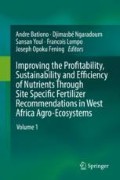Abstract
Maize, rice and millet yield are very low in Mali due to low fertilizer use. The research results reported here are based on work carried out in the different agroecological zones (AEZs) in Mali for Africa, with a structure of treatments allowing the determination of the response functions for nitrogen (N), phosphorus (P) and potassium (K) on maize, rice and millet. A diagnostic treatment including Zn, Mg, and B was compared with the same NPK treatment to evaluate the effect of micronutrients. The results will be combined with research conducted under similar agro-ecological conditions to develop robust response functions for the different crops and ensure greater profit in fertilizer use decisions.
The fertilizer rates that were tested within the framework of the study showed different effects according to crops and AEZs. The combinations across the three agro-ecological zones showed that higher rates such as those blankets recommended would not be economically profitable. The same observation was made for conventional and hybrid maize. For maize, the best combinations across the three agro-ecological zones were: 90N 10P 0K, 90N 30P 0K, 30N 40P 0K, 120N 30P 0k, 60N 30P 10K, 60N 30P 30K.
Application of N, P, and K did not affect yields of upland rice, but there were significant differences in the yields of lowland rice and irrigated rice. Average yields were 2.482, 2.808 and 4.71 t/ha for upland, lowland and irrigated rice respectively. A diagnostic treatment including N, P, K, Mg, S, Zn, and B had a significant effect on lowland rice (rain fed and irrigated) but not on upland rice compared to N, P, and K alone. Nutrients effects were specific to each area and production conditions. The Fertilizer Optimization Tool (FOT) developed in the framework of the OFRA project allowed to propose economic rates lower than the current recommendations and for each type of rice cropping system depending on the agro-ecological zones.
The fertilizer rates that were tested showed significant differences between treatments, regardless of soil type. As sole crop, millet gave yields significantly higher than that usually found in farmers’ fields around the station (1500 average against 800 to 1000 kg/ha). It is concluded that the application of 22.5 P combined with 40 or 60N and that of 30P without N and K significantly improve millet grain yield. The best yields were achieved with P rates higher than that recommended (46P2O5) for millet fertilization.
References
Bucheyeki, T. L., Shennkalwa, E., Kadadi, D., & Lobulu, J. (2011). Assessment of rice production constraints and farmers preferences in Nzega and Igunga districts. Journal of Advanced Development Research, 2, 30–37.
Dicko M. (2005). Analyse du fonctionnement d’une parcelle irriguée sur sol alcalin. Application à la gestion intégrée de la fertilisation azotée et du calendrier cultural dans le delta intérieur du fleuve Niger (Mali. PhD thesis.
Direction Nationale de l’Agriculture. (2012). Rapport de Campagne.
FAO. (2013). Suivi des politiques agricole et alimentaires en Afrique: Analyse des incitations et penalisations pour le Mali. http://www.fao.org/3/a-at569f.pdf. consulté le 26 juin 2016.
FAOSTAT. (2015). FAO statistical pocketbook. World Food and Agriculture 2015. ISBN 978-92-5-108802-9 http://www.fao.org/3/a-i4691e.pdf
Johnston, A. M., & Bruulsema, T. W. (2014). 4R Nutrient stewardship for improved nutrient use efficiency. Procedia Engineering, 83, 365–370.
Keita, B., Kounkandi, B, & Dioni, L. (1991). Etude morphopédologique du kala inférieur au 1/20000, IER/MALI: 77 pages + annexes.
Laboratoire Sol-Eau-Plante. (2000). Carte des Zones Agro-Ecologiques du Mali. © LaboSEP: IER, 2000.
Rugumanu. (2014). Empowering smallholder rice farmers in Tanzania to increase productivity for promoting food security in Eastern and Southern Africa. Agriculture & Food Security, 3, 7. https://doi.org/10.1186/2048-7010-3-7. © Rugumamu; licensee BioMed Central Ltd. 2014. Received: 11 January 2014. Accepted: 24 March 2014. Published: 21 April 2014.
Wopereis, M. C. S., Donovan, C., Nebié, B., Guindo, D., & N’diaye, M. K. (1999). Soil fertility management in irrigated rice systems in the Sahel and Savannah regions. Part I. Agronomic analysis. Field Crops Research, 61, 125–145.
Author information
Authors and Affiliations
Corresponding author
Editor information
Editors and Affiliations
Rights and permissions
Copyright information
© 2018 Springer International Publishing AG, part of Springer Nature
About this chapter
Cite this chapter
Dicko, M.K. et al. (2018). Response of Rice, Maize and Millet to Fertilizers in Mali. In: Bationo, A., Ngaradoum, D., Youl, S., Lompo, F., Fening, J. (eds) Improving the Profitability, Sustainability and Efficiency of Nutrients Through Site Specific Fertilizer Recommendations in West Africa Agro-Ecosystems. Springer, Cham. https://doi.org/10.1007/978-3-319-58789-9_8
Download citation
DOI: https://doi.org/10.1007/978-3-319-58789-9_8
Published:
Publisher Name: Springer, Cham
Print ISBN: 978-3-319-58788-2
Online ISBN: 978-3-319-58789-9
eBook Packages: Biomedical and Life SciencesBiomedical and Life Sciences (R0)

